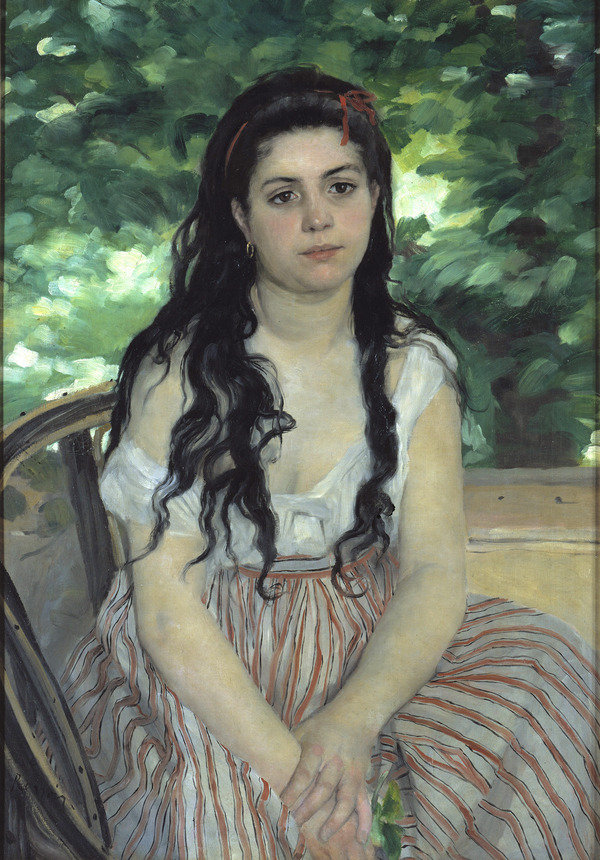Renoir
dal 31/3/2012 al 11/8/2012
Segnalato da
31/3/2012
Renoir
Kunstmuseum Basel, Basel
Between Bohemia and Bourgeoisie: The Early Years. Fifty painting - portraits, landscapes, and still lifes, among them masterworks from the collections of major museums such as the Musee d'Orsay, Paris, the National Gallery, London, the Metropolitan Museum, New York, and the Art Institute of Chicago, as well as virtually unknown works from private collections, form a magnificent panorama of the formative years of Renoir's art.

From April 1 to August 12, 2012, the spectacular exhibition Renoir. Between Bohemia
and Bourgeoisie: The Early Years at the Kunstmuseum Basel will focus on the
underappreciated early work of the great painter Pierre-Auguste Renoir (1841–1919).
Fifty paintings—portraits, landscapes, and still lifes, among them masterworks from
the collections of major museums such as the Musée d’Orsay, Paris, the National
Gallery, London, the Metropolitan Museum, New York, and the Art Institute of
Chicago, as well as virtually unknown works from private collections, form a
magnificent panorama of the formative years of Renoir’s art.
Pierre-Auguste Renoir was among the French painters who founded Impressionism. With a
light palette, loose brushwork, and motifs from modern urban life and leisurely amusements
in natural settings, he and his fellow innovators wrote art history. The painter’s Impressionist
period and his late work have subsequently tended to eclipse other parts of his oeuvre.
He has been celebrated as the “painter of happiness,” but that has also been a cliché to
which he was reduced..
The Kunstmuseum Basel now presents a grand survey exhibition, the first show ever to
emphasize the artist’s outstanding and surprisingly complex early work, up to and including
the eminent Impressionist paintings of the 1870s.
Renoir’s most important model during these first years of his career was his lover, Lise
Tréhot. Their relationship lasted from 1865 to 1872. Lise sat for a series of important early
works in which he staged her in a wide variety of roles and pictorial genres. This group of
paintings constitutes a highlight of the exhibition. The two illegitimate children who issued
from the relationship with Lise were given up for adoption—a fact that the artist kept secret
throughout his life and that puts a new complexion on the ostensibly perfect idylls in his
pictures of pairs of lovers and mothers with children.
Portraits of his friends and fellow artists Claude Monet, Frédéric Bazille, and Alfred Sisley
form another distinct group. Renoir’s own contribution to Impressionism is most clearly
apparent in his landscapes, especially those of the countryside around Paris, and in his
scenes of la vie moderne.
The period from the mid-1860s to the late 1870s is defined by extraordinary social, political,
and artistic developments. The tensions between bohemia and the bourgeoisie, two milieus
in which Renoir moved, are readily apparent in his oeuvre. He experienced the political sea
changes from the conservative climate of the Second Empire to the revolution of the Paris
Commune and hence to the Third Republic, even as he avoided involvement in these
conflicts whenever possible. A young artist’s chances of achieving visibility depended on his
work being shown in the Salon. Renoir and his fellow Impressionists rebelled against that
institution by organizing exhibitions of their own. In the late 1870s, however, as his work
slowly found official recognition, his attitude toward the Salon grew friendlier as well.
Renoir’s early work lets us trace his evolution as an artist in fascinating paintings. Paintings
from this period reflect the growing range of his pictorial imagination as he spent many days
studying the paintings at the Louvre, but also took in the revolutionary innovations of his
time: the realism of Gustave Courbet, the Barbizon school’s en plein air painting, and the
inspirations he received from Édouard Manet and Claude Monet, his closest artistic
associates at the time.
An extensive catalogue in German and English accompanies the exhibition. Published by
Hatje Cantz, it will feature contributions by Michael F. Zimmermann, Sylvie Patry, Augustin
de Butler, Marc Le Cœur, Peter Kropmanns, David Pullins, Stefanie Manthey, and Nina
Zimmer.
We are preparing a wide-ranging program of art education events for children, schools, and
families, as well as an international scholarly symposium to be held on June 29 and 30,
2012.
With generous support from:
Credit Suisse AG
Swisslos Basel-Landschaft
Peter und Simone Forcart-Staehelin
L. + Th. La Roche Stiftung
Sackler Stiftung
Stiftung für das Kunstmuseum Basel
Press relations
Kunstmuseum Basel, Christian Selz
St. Alban-Graben 8, CH–4010 Basel
Telephone +41 61 206 62 06
Fax +41 61 206 62 52
pressoffice@kunstmuseumbasel.ch
www.kunstmuseumbasel.ch
Image: En été, 1868. Oil on canvas 85 × 59 cm (33.5 × 23.2 in)
Kunstmuseum Basel
St. Alban-Graben 16 - Basel
Opening Hours: Tue - Sun 10 a.m. - 6 p.m.
closed on Monday
Admission:
Adults over 19 years 15 CHF
Teenagers 13-19 years 8 CHF
Students 20-30 years 8 CHF
Disabled visitors with ID 8 CHF
Groups (over 19 pers.) 10 CHF
Artists with valid identification 10 CHF
Freiw. Museumsverein Basel, freiw. akad. Gesellsch. Basel free



